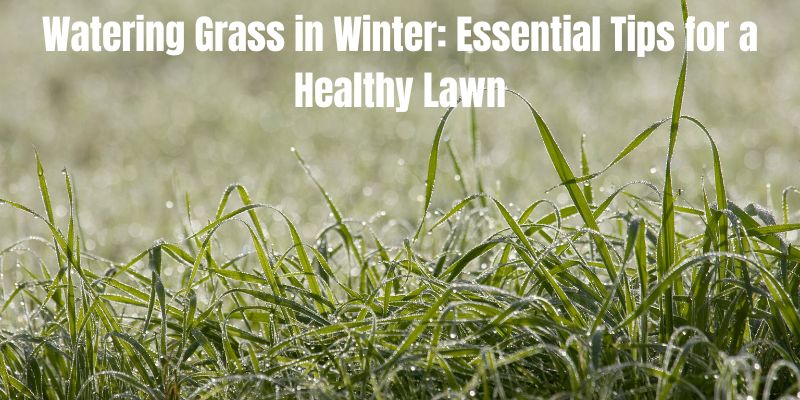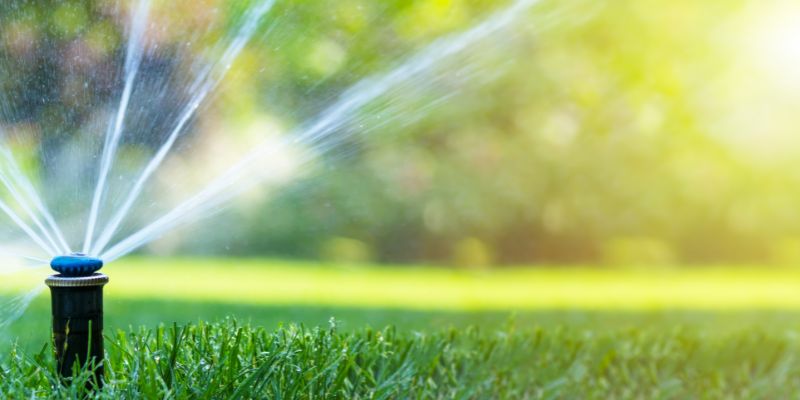Many homeowners think lawn care stops when winter arrives. However, proper watering during colder months can make a big difference in your grass’s health. This guide will help you understand when and how to water your lawn in winter, ensuring it stays green and strong all year round.

Should You Water Grass in Winter?
The need to water your grass in winter depends on several factors. Where you live plays a big role. In areas with mild winters, grass may need regular watering. However, in colder regions, natural precipitation might be enough.
The type of grass you have also matters. Cool-season grasses like Kentucky bluegrass and fescue might need less water in winter. Warm-season grasses such as Bermuda and zoysia usually go dormant and require minimal watering.
Soil type is another important factor. Sandy soils drain quickly and may need more frequent watering. Clay soils hold water longer and might need less frequent watering.
Watering in winter can help prevent grass from drying out and dying. It also keeps the soil from becoming too dry, which can damage grass roots. However, be careful not to overwater. Too much water can lead to fungal growth and other lawn problems.
How to Water Grass in Winter
In winter, you’ll need to water less often than in summer. Instead of daily watering, you might only need to water once every week or two. The key is to check your soil moisture. If the top inch of soil feels dry, it’s time to water.
When you do water, do it deeply. This encourages grass roots to grow deeper, making your lawn more resistant to drought and cold. Water until the soil is moist about 6 inches deep.
Best Time to Water Grass in Winter
The best time to water grass in winter is mid-morning. This gives the water time to soak in before nightfall. Watering at night in winter can lead to ice formation, which can damage your grass.

Always check the weather forecast before watering. If rain or snow is expected, hold off on watering. Also, don’t water when temperatures are near or below freezing. This can cause ice to form on your grass, potentially harming it.
Read Also: When is the best time water grass in hot weather?
Winter Watering for Different Grass Types
Cool-season grasses generally need less water in winter. They grow most actively in cooler weather, so they might need some water during dry spells. However, they can often survive on natural rainfall alone.
Warm-season grasses usually go dormant in winter. They turn brown and stop growing. These grasses need very little water during their dormant period. Only water if you have a long dry spell with no rain or snow.
Special Winter Watering Situations
If you’ve recently planted new grass seed or laid new sod, you’ll need to water more often. New grass has shallow roots and dries out quickly. Water lightly but frequently until the grass is well-established.
In areas prone to drought, winter watering becomes more important. Even if your grass is dormant, it still needs some moisture to stay alive. Water deeply but infrequently to help your grass survive dry periods.
In snowy areas, you might not need to water at all. Snow acts as a natural insulator and provides moisture as it melts. However, during dry spells between snowfalls, you might need to water occasionally.
Tools for Winter Watering
If you have an irrigation system, make sure to winterize it to prevent freezing and damage. For manual watering, a regular garden hose works well. You can also use a sprinkler, but be sure to drain it after each use to prevent freezing.
A rain gauge can help you track natural precipitation. This way, you’ll know if your lawn is getting enough water from rain and snow.
Common Winter Lawn Care Mistakes
Overwatering: Overwatering is a common mistake in winter. Too much water can lead to fungal growth and root rot. Always check soil moisture before watering.
Walking on frozen grass: Walking on frozen grass can damage it. The frozen blades can break easily, leading to bare spots in your lawn. Try to limit foot traffic on your lawn during freezing weather.
Neglecting other winter lawn care tasks: Don’t forget other winter lawn care tasks. Raking leaves, removing debris, and avoiding the use of de-icing salts near your grass are all important for winter lawn health.
FAQs
How often should I water my lawn in winter?
The frequency depends on your climate, grass type, and soil. In general, water less often than in summer. Check soil moisture weekly. If the top inch of soil is dry, it’s time to water. In many areas, watering every 2-3 weeks is enough. Always adjust based on rainfall and your specific lawn needs.
Can I water my grass when it’s freezing outside?
It’s best not to water when temperatures are at or below freezing. Water can freeze on grass blades and soil, potentially damaging your lawn. If you must water during cold snaps, do it when temperatures are above freezing and the water has time to soak in before nightfall.
Do I need to water my lawn if there’s snow on the ground?
Usually, snow provides enough moisture for your lawn. As snow melts, it slowly waters your grass. However, during long dry spells between snowfalls, you might need to water if the soil becomes very dry. Check soil moisture under the snow to decide.
What signs indicate that my grass needs water in winter?
Look for signs of drought stress, even in winter. These include grass turning a dull gray-green color, footprints remaining visible in the grass long after walking on it, and soil feeling dry several inches deep. If you see these signs, it’s time to water your lawn.
How can I prevent winter lawn damage related to watering?
To prevent water-related damage, avoid overwatering, which can lead to fungal growth. Don’t water when temperatures are near freezing to prevent ice formation. Water early in the day so grass can dry before night. Lastly, reduce foot traffic on wet or frozen grass to prevent damage.
Final Thoughts
Proper winter watering is key to maintaining a healthy lawn year-round. By understanding your grass type, local climate, and soil conditions, you can provide the right amount of water to keep your lawn strong through the cold months. Remember to adjust your watering habits based on weather conditions and always be mindful of potential freezing. With these tips, you’ll be well-equipped to care for your grass in winter, ensuring a lush, vibrant lawn when spring arrives.


